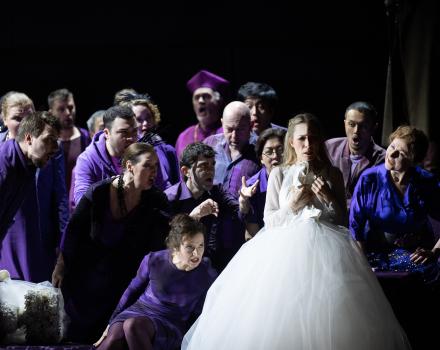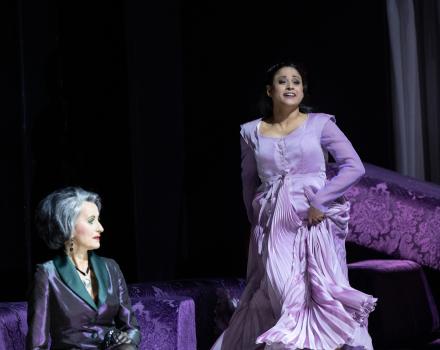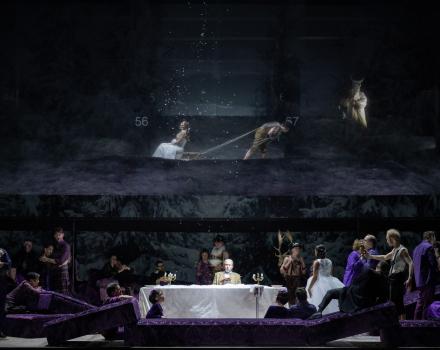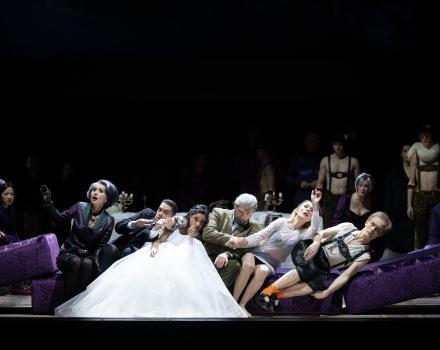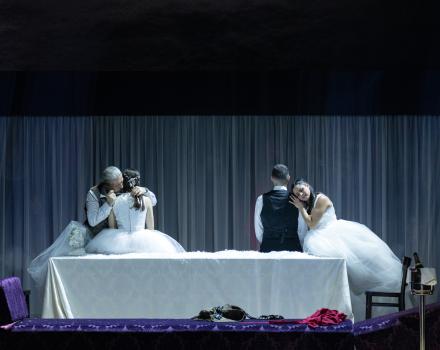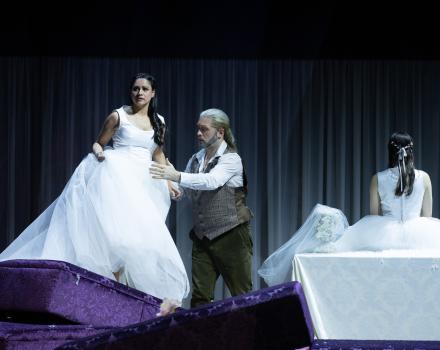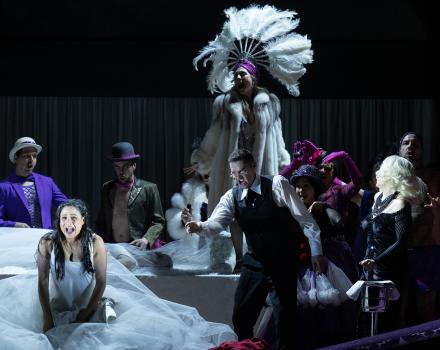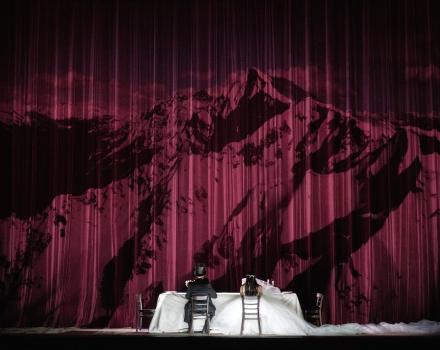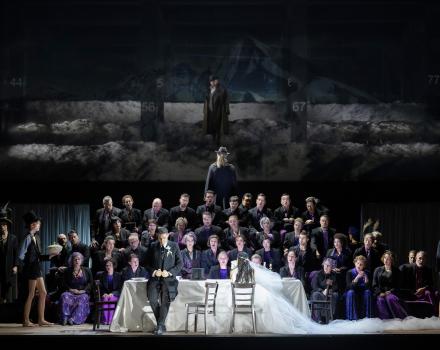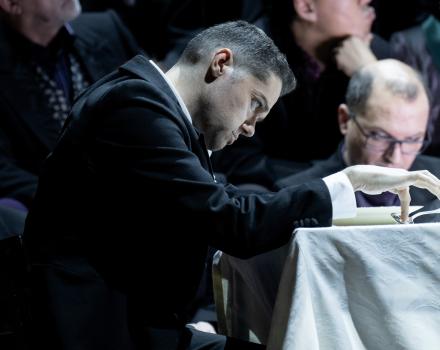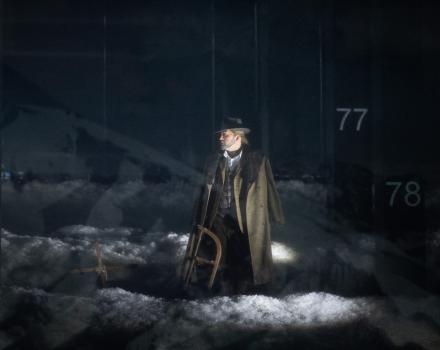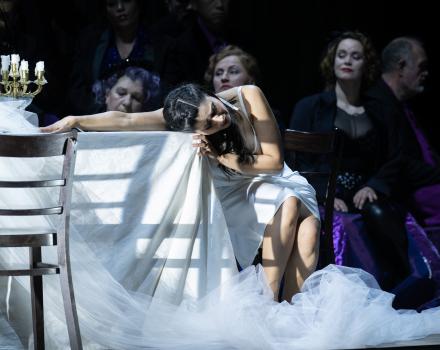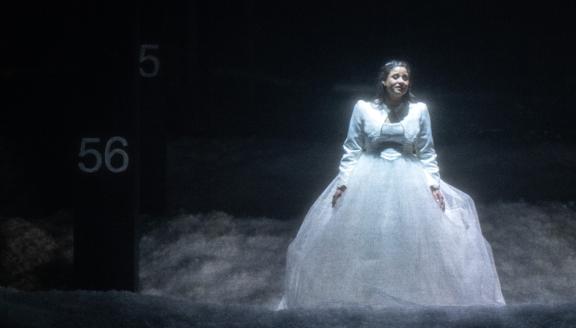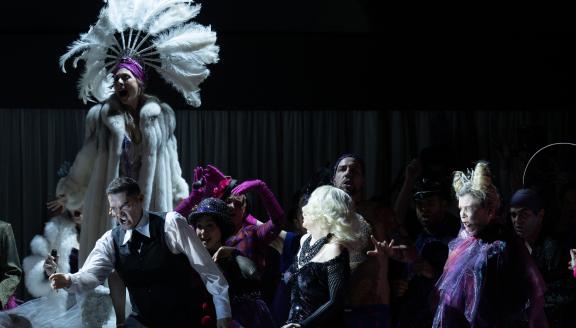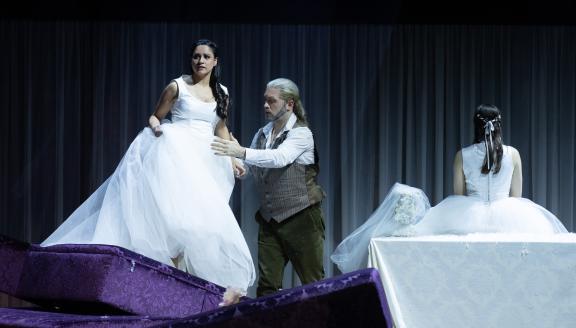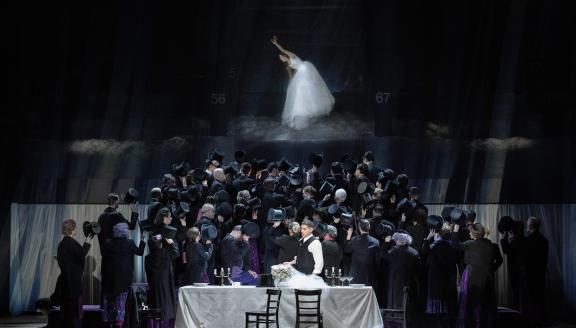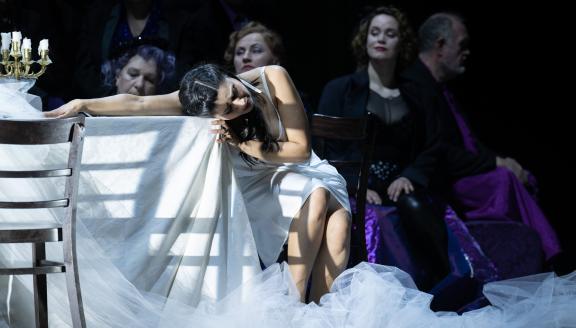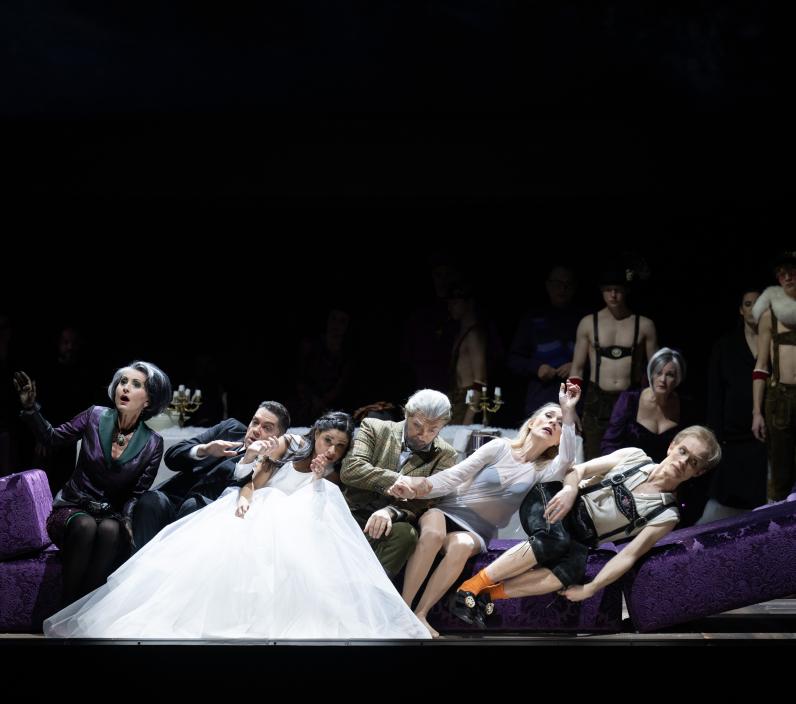
In an apparent idyll high in the Swiss Alps, a secluded village society prepares for the next wedding. Amina is to be the lucky one this time. The groom Elvino, however, soon turns his attention back to his former wife because Amina sleepwalks into the bed of a stranger who has just arrived. Count Rodolfo, son of the former lord of the manor and travelling incognito, cannot convince the villagers of his innocence nor that of Amina, until she sleepwalks again and the collective belief in the supernatural is put to the test.
With its pastoral setting, its Utopian vision of a harmoniously ordered society and a happy ending reached by way of situations of great poignancy, La sonnambula is Bellini’s first mature masterpiece. Here he extends the expressive range of his lyricism with the most beautiful coloratura and lilting melodies; from Anima’s opening aria - which embraces ecstatic introspection, tender recitative-like musings and exuberant virtuosity - to her heart-breaking closing scene. Bellini creates a sense of the lead characters being part of a close-knit community by a constant musical interaction between the soloists and chorus. Deutsche Oper am Rhein’s new production is conducted by bel canto specialist and Principal Guest Conductor Antonino Fogliani and is directed by Johannes Erath, whose poetically subtle stagings have been seen in Munich, Frankfurt, Vienna, Palermo and beyond.
CAST
|
Count Rodolfo
|
Bogdan Taloș
|
|---|---|
|
Teresa
|
Katarzyna Kuncio
|
|
Amina
|
Stacey Alleaume
|
|
Elvino
|
Edgardo Rocha
|
|
Lisa
|
Heidi Elisabeth Meier
|
|
Alessio
|
Valentin Ruckebier
|
|
A notary
|
Apostolos Zoidis
|
|
Chorus
|
Chor der Deutschen Oper am Rhein
|
|
Orchestra
|
Düsseldorfer Symphoniker
|
| ... | |
|
Music
|
Vincenzo Bellini
|
|---|---|
|
Text
|
Felice Romani
|
|
Conductor
|
Antonino Fogliani
|
|
Director
|
Johannes Erath
|
|
Sets
|
Bernhard Hammer
|
|
Costumes
|
Jorge Jara
|
|
Chorus master
|
Patrick Francis Chestnut
|
|
Lighting
|
Nicol Hungsberg
|
|
Video
|
Bibi Abel
|
|
Dramaturgy
|
Anna Melcher
|
| ... | |
Text by Felice Romani after the libretto by Eugène Scribe for the action ballet "La Somnambule, ou L'Arrivée d'un nouveau seigneur" (1827) by Jean-Pierre Aumer and Ferdinand Hérold.
VIDEOS
STORY
ACT 1
Lisa is in love with Elvino. He is the most eligible bachelor in an isolated community in the Swiss Alps. The two of them used to be together, but now Elvino is to marry Amina. Lisa is distraught and furious to see the man she loves marry someone else. Meanwhile, Alessio is in love with Lisa. He rehearses the villagers in a song celebrating the couple’s wedding, happy that Lisa will not be the bride. But Lisa brusquely rejects his advances. Amina is an orphan, who was brought up by the miller’s wife Theresa, and she is delighted at the prospect of her forthcoming marriage. She thanks everyone for the song and wishes Alessio luck with Lisa, who rejects him again.
Elvino arrives late, apologising that he visited his mother’s grave to ask her blessing for the marriage. He compares Amina with his late mother. The marriage contract is drafted: Elvino will contribute his house, property and good name to the marriage, Amina nothing but her heart. Elvino gives his bride his mother’s ring and some flowers. The church ceremony will happen tomorrow.
A stranger arrives in the village calling himself Rodolfo. Lisa offers to let him spend the night in her guest room. The stranger seems to know the village. When he sees Amina, she reminds him of a girl he loved and lost. Amina also feels he is strangely familiar. Rodolfo is told that the old Count has died and his son has been missing for years. He assures the villagers that the son is alive.
Theresa announces that it is the witching hour: a strange white creature has been ap- pearing at night with wild hair, capable of bringing the streams to a standstill. Rodolfo curses this collective superstition and decides to take Lisa’s guest room for the night. Elvino is jealous: he has not missed the complicity between Rodolfo and Amina.
In the guest room, Lisa reveals to Rudolfo that she has recognised him as the Count’s son. Their ensuing erotic encounter is abruptly interrupted by Amina. She is sleepwalking and mistakes Rodolfo for Elvino. Still sleeping, she imagines her dream wedding, and Rodolfo does nothing to wake her.
The villagers want to celebrate their new Count but find Amina in his bed instead. Lisa alerts Elvino – and Amina’s infidelity seems obvious for all to see. Elvino abandons Amina, who protests her innocence in vain. She is met with widespread disbelief. Only Theresa discovers an item of Lisa’s clothing which puzzles her.
ACT 2
The villagers plan to appeal to Rodolfo to intercede with Elvino for Amina. Elvino sinks into despondency; he does not believe a word Amina says. Even when the crowd tells him that Rodolfo has proclaimed her innocent, he does not want to hear of it and pulls his mother’s ring off Amina’s finger.
Alessio again tries to court Lisa, unsuccessfully. When Elvino names her as his new bride, she agrees immediately. Rodolfo explains that Amina is a sleepwalker, but nobody believes him. Lisa asserts her right to marry Elvino and says that she would not be found hanging around in the Count’s room. Theresa, however, reveals the item of clothing that Lisa left behind. Now Elvino feels that both women have cheated on him. He demands proof. Then, Amina is seen high up, balancing on a narrow ledge, crying for her lost love. She must not be woken, or else she might fall…
INSIGHTS
A Happy End
by Anna Melcher, dramaturg
Amina balances on the precipice. Can this end well? Is it possible in view of what has happened? Would Amina just take Elvino in her arms again after his lack of trust, rejection not to mention his revived interest in his ex? Can Elvino so easily get the image of the mistress in the other's bed out of his head? Gnawing doubts - well, not much sign on it.
La sonnambula is an 'opera semiseria' characterised by a juxtaposition of serious and light-hearted elements and an obligatory lieto fine. This ‘happy ending’ has been an integral part of dramaturgy since the beginning of opera and remained central to the ethics of 18th-century Enlightenment opera. Following the example of the bourgeois drama, characters from different social classes now came together, often in an idyllic setting. From the late 18th century onwards, the monopoly of the happy ending was increasingly shaken - for example, Rossini's Tancredi, which was first performed with lieto fine in Venice in 1813, then with a tragic ending in Ferrara and finally with a happy ending again in Milan and it was still popular with audiences. Musicologist Arnold Jacobshagen links 'opera semiseria' to the transition from late absolutism to the bourgeois culture of Italy at the time of the Restoration and the Risorgimento:‘ The sentimental, half-simple opera corresponded well to a zeitgeist that was particularly receptive to the perceived fragility of human feeling.’
Vincenzo Bellini gave this fragility a deeply moving musical voice, which still touches us directly today, especially in troubled, disturbing times. His infinite rich melody makes the opera stage a space of possibility; a space for a moment of inner escape, for a moment of surrender to imagine a world in which things could end badly but also well. Rodolfo was wrong, by the way, ‘Ah! non si dèsti’; not waking the sleepwalker does not save her from falling, there is no such thing as certainty for sleepwalkers. Fans of lieto fine are advised to sleepwalker-proof their doors and windows, and to secure stair wells and other ledges for good.
Extract of a longer article reproduced in the Deutsche Oper am Rhein La sonnambula programme.
Augmented Reality Opera
With the app "OpAR - Augmented Reality Opera" from the Deutsche Oper am Rhein, you can bring artists from La sonnambula, among others, via augmented reality into your own living room. Download now in the App Store, activate the home mode and experience the singers virtually on your own couch! You can find more information here.
GALLERY
